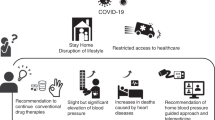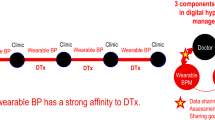Abstract
Awareness, treatment, and control of hypertension are of the utmost importance in conquering stroke and cardiovascular disease. To reduce the global burden of hypertension, the Japanese Society of Hypertension (JSH) established the “JSH Future Plan” based on an increasing need to transform the strategy for combating hypertension. In addition to energizing conventional approaches in basic, translational, and clinical research, the application of rapidly evolving digital health technologies and artificial intelligence to hypertension healthcare and research (digital hypertension) holds promise for providing further insights into the pathophysiology and therapeutic targets and implementing predictive, personalized, and preemptive approaches in clinical practice. With great potential to revolutionize the landscape of hypertension, digital hypertension has some technical, legal, ethical, social, and financial issues to overcome. Given the multidisciplinary framework, digital hypertension requires comprehensive and strategic collaboration among industry, academia, and government to move forward toward the goal of “Future Medicine”.
This is a preview of subscription content, access via your institution
Access options
Subscribe to this journal
Receive 12 print issues and online access
$259.00 per year
only $21.58 per issue
Buy this article
- Purchase on Springer Link
- Instant access to full article PDF
Prices may be subject to local taxes which are calculated during checkout

Similar content being viewed by others
References
World Health Organization. A global brief on hypertension. WHO Press; Geneva, Switzerland 2013.
Ikeda N, Saito E, Kondo N, Inoue M, Ikeda S, Satoh T, et al. What has made the population of Japan healthy? Lancet. 2011;378:1094–105.
Ikeda N, Inoue M, Iso H, Ikeda S, Satoh T, Noda M, et al. Adult mortality attributable to preventable risk factors for non-communicable diseases and injuries in Japan: a comparative risk assessment. PLoS Med. 2012;9:e1001160.
Satoh A, Arima H, Ohkubo T, Nishi N, Okuda N, Ae R, et al. Associations of socioeconomic status with prevalence, awareness, treatment, and control of hypertension in a general Japanese population: NIPPON DATA2010. J Hypertens. 2017;35:401–8.
Umemura S, Arima H, Arima S, Asayama K, Dohi Y, Hirooka Y, et al. The Japanese Society of Hypertension Guidelines for the Management of Hypertension (JSH 2019). Hypertens Res. 2019;42:1235–481.
Yasuda S, Miyamoto Y, Ogawa H. Current status of cardiovascular medicine in the Aging Society of Japan. Circulation. 2018;138:965–7.
Komuro I, Kaneko H, Morita H, Isobe M, Nakayama H, Minematsu K, et al. Nationwide actions against heart failure pandemic in Japan—what should we do from academia? Circ J. 2019;83:1819–21.
Toyoda K, Inoue M, Koga M. Small but steady steps in stroke medicine in Japan. J Am Heart Assoc. 2019;8:e013306.
Nakayama H, Minematsu K, Yamaguchi T, Miyamoto S, Isobe M, Komuro I, et al. Approval of Stroke and Cardiovascular Disease Control Act in Japan: comprehensive nationwide approach for prevention, treatment, and patients’ support. Int J Stroke. 2020;15:7–8.
Node K, Kishi T, Tanaka A, Itoh H, Rakugi H, Ohya Y, et al. The Japanese Society of Hypertension—digest of plan for the future. Hypertens Res. 2018;41:989–90.
Dzau VJ, Balatbat CA. Future of hypertension. Hypertension. 2019;74:450–7.
Suchard MA, Schuemie MJ, Krumholz HM, You SC, Chen R, Pratt N, et al. Comprehensive comparative effectiveness and safety of first-line antihypertensive drug classes: a systematic, multinational, large-scale analysis. Lancet. 2019;394:1816–26.
Rudrapatna VA, Butte AJ. Opportunities and challenges in using real-world data for health care. J Clin Invest. 2020;130:565–74.
Kawaguchi H, Koike S, Ohe K. Facility and regional factors associated with the new adoption of electronic medical records in Japan: nationwide longitudinal observational study. JMIR Med Inf. 2019;7:e14026.
Ministry of Health, Labour and Welfare, Japan. Facilitation in informatization in healthcare field. Ministry of Health, Labour and Welfare, Japan; Tokyo, Japan 2018. https://www.mhlw.go.jp/stf/seisakunitsuite/bunya/kenkou_iryou/iryou/johoka/.
Kawaguchi H, Koike S, Ohe K. Regional differences in electronic medical record adoption in Japan: a nationwide longitudinal ecological study. Int J Med Inf. 2018;115:114–9.
Yasunaga H, Imamura T, Yamaki S, Endo H. Computerizing medical records in Japan. Int J Med Inf. 2008;77:708–13.
Kanakubo T, Kharrazi H. Comparing the trends of electronic health record adoption among hospitals of the United States and Japan. J Med Syst. 2019;43:224.
Blumenthal D. Stimulating the adoption of health information technology. N Engl J Med. 2009;360:1477–9.
Adler-Milstein J, Jha AK. HITECH act drove large gains in hospital electronic health record adoption. Health Aff. 2017;36:1416–22.
Kimura M, Nakayasu K, Ohshima Y, Fujita N, Nakashima N, Jozaki H, et al. SS-MIX: a ministry project to promote standardized healthcare information exchange. Methods Inf Med. 2011;50:131–9.
Tanaka K, Yamamoto R, Nakasho K, Miyaji A. Development of a secure cross-institutional data collection system based on distributed standardized EMR storage. Stud Health Technol Inf. 2018;255:35–9.
Tanaka K, Yamamoto R. Assessment of traceability implementation of a cross-institutional secure data collection system based on distributed standardized EMR storage. Stud Health Technol Inf. 2019;264:1373–7.
Yamada K, Itoh M, Fujimura Y, Kimura M, Murata K, Nakashima N, et al. The utilization and challenges of Japan’s MID-NET® medical information database network in postmarketing drug safety assessments: a summary of pilot pharmacoepidemiological studies. Pharmacoepidemiol Drug Saf. 2019;28:601–8.
Sugiyama T, Miyo K, Tsujimoto T, Kominami R, Ohtsu H, Ohsugi M, et al. Design of and rationale for the Japan Diabetes compREhensive database project based on an Advanced electronic Medical record System (J-DREAMS). Diabetol Int. 2017;8:375–82.
Nakagawa N, Sofue T, Kanda E, Nagasu H, Matsushita K, Nangaku M, et al. J-CKD-DB: a nationwide multicentre electronic health record-based chronic kidney disease database in Japan. Sci Rep. 2020;10:7351.
Virnig BA, McBean M. Administrative data for public health surveillance and planning. Annu Rev Public Health. 2001;22:213–30.
Matsuda S, Fujimori K, Kuwabara K, Ishikawa KB, Fushimi K. Diagnosis procedure combination as an infrastructure for the clinical study. Asian Pac J Dis Manag. 2011;5:81–87.
Ishikawa KB. Medical big data for research use: current status and related issues. Jpn Med Assoc J. 2016;59:110–24.
Yamana H, Moriwaki M, Horiguchi H, Kodan M, Fushimi K, Yasunaga H. Validity of diagnoses, procedures, and laboratory data in Japanese administrative data. J Epidemiol. 2017;27:476–82.
Matsuda K. Hospitals and big data: use of case mix and e-claim data in Japan. Jpn Hosp. 2016:45–52. https://pubmed.ncbi.nlm.nih.gov/30226961/.
Riva-Rocci S, Zanchetti A, Mancia G. A new sphygmomanometer. Sphygmomanometric technique. J Hypertens. 1996;14:1–12.
Mancia G, Zanchetti A. One hundred years of auscultatory blood pressure: commemorating N. S. Korotkoff. J Hypertens. 2005;23:1–2.
Kain HK, Hinman AT, Sokolow M. Arterial blood pressure measurements with a portable recorder in hypertensive patients. I. Variability and correlation with “casual” pressures. Circulation. 1964;30:882–92.
Pickering TG, Shimbo D, Haas D. Ambulatory blood-pressure monitoring. N Engl J Med. 2006;354:2368–74.
Mancia G, Verdecchia P. Clinical value of ambulatory blood pressure: evidence and limits. Circ Res. 2015;116:1034–45.
Gorostidi M, Vinyoles E, Banegas JR, de la Sierra A. Prevalence of white-coat and masked hypertension in national and international registries. Hypertens Res. 2015;38:1–7.
Asayama K, Satoh M, Kikuya M. Diurnal blood pressure changes. Hypertens Res. 2018;41:669–78.
Asayama K, Wei FF, Liu YP, Hara A, Gu YM, Schutte R, et al. Does blood pressure variability contribute to risk stratification? Methodological issues and a review of outcome studies based on home blood pressure. Hypertens Res. 2015;38:97–101.
We Are Social Inc. Digital in 2020. We Are Social Inc; New York, USA 2020. https://wearesocial.com/digital-2020.
Burke LE, Ma J, Azar KM, Bennett GG, Peterson ED, Zheng Y, et al. Current science on consumer use of mobile health for cardiovascular disease prevention: a scientific statement from the American Heart Association. Circulation. 2015;132:1157–213.
Margolis KL, Asche SE, Bergdall AR, Dehmer SP, Groen SE, Kadrmas HM, et al. Effect of home blood pressure telemonitoring and pharmacist management on blood pressure control: a cluster randomized clinical trial. JAMA. 2013;310:46–56.
Omboni S, Gazzola T, Carabelli G, Parati G. Clinical usefulness and cost effectiveness of home blood pressure telemonitoring: meta-analysis of randomized controlled studies. J Hypertens. 2013;31:455–67.
Duan Y, Xie Z, Dong F, Wu Z, Lin Z, Sun N, et al. Effectiveness of home blood pressure telemonitoring: a systematic review and meta-analysis of randomised controlled studies. J Hum Hypertens. 2017;31:427–37.
Ministry of Internal Affairs and Communications, Japan. 2019 White Paper on Information and Communications in Japan. inistry of Internal Affairs and Communications, Japan; Tokyo, Japan 2019. https://www.soumu.go.jp/johotsusintokei/whitepaper/eng/WP2019/2019-index.html.
Milani RV, Lavie CJ, Bober RM, Milani AR, Ventura HO. Improving hypertension control and patient engagement using digital tools. Am J Med. 2017;130:14–20.
Shan R, Ding J, Plante TB, Martin SS. Mobile health access and use among individuals with or at risk for cardiovascular disease: 2018 Health Information National Trends Survey (HINTS). J Am Heart Assoc. 2019;8:e014390.
Lu X, Yang H, Xia X, Lu X, Lin J, Liu F, et al. Interactive mobile health intervention and blood pressure management in adults. Hypertension. 2019;74:697–704.
Kuwabara M, Harada K, Hishiki Y, Kario K. Validation of two watch-type wearable blood pressure monitors according to the ANSI/AAMI/ISO81060-2:2013 guidelines: Omron HEM-6410T-ZM and HEM-6410T-ZL. J Clin Hypertens. 2019;21:853–8.
Weenk M, van Goor H, van Acht M, Engelen LJ, van de Belt TH, Bredie SJH. A smart all-in-one device to measure vital signs in admitted patients. PLoS ONE. 2018;13:e0190138.
Matwyshyn AM. The Internet of Bodies. Wm. & Mary L. Rev. 2019;61:77–167.
Roehrs A, da Costa CA, Righi RD, de Oliveira KS. Personal health records: a systematic literature review. J Med Internet Res. 2017;19:e13.
LeCun Y, Bengio Y, Hinton G. Deep learning. Nature. 2015;521:436–44.
Esteva A, Robicquet A, Ramsundar B, Kuleshov V, DePristo M, Chou K, et al. A guide to deep learning in healthcare. Nat Med. 2019;25:24–9.
Topol EJ. High-performance medicine: the convergence of human and artificial intelligence. Nat Med. 2019;25:44–56.
Silver D, Huang A, Maddison CJ, Guez A, Sifre L, van den Driessche G, et al. Mastering the game of Go with deep neural networks and tree search. Nature. 2016;529:484–9.
McKinney SM, Sieniek M, Godbole V, Godwin J, Antropova N, Ashrafian H, et al. International evaluation of an AI system for breast cancer screening. Nature. 2020;577:89–94.
Rajkomar A, Dean J, Kohane I. Machine learning in medicine. N Engl J Med. 2019;380:1347–58.
Makino M, Yoshimoto R, Ono M, Itoko T, Katsuki T, Koseki A, et al. Artificial intelligence predicts the progression of diabetic kidney disease using big data machine learning. Sci Rep. 2019;9:11862.
Christiansen EM, Yang SJ, Ando DM, Javaherian A, Skibinski G, Lipnick S, et al. In silico labeling: predicting fluorescent labels in unlabeled images. Cell. 2018;173:792–803.e719.
Ota S, Horisaki R, Kawamura Y, Ugawa M, Sato I, Hashimoto K, et al. Ghost cytometry. Science. 2018;360:1246–51.
He J, Baxter SL, Xu J, Xu J, Zhou X, Zhang K. The practical implementation of artificial intelligence technologies in medicine. Nat Med. 2019;25:30–6.
Author information
Authors and Affiliations
Corresponding author
Ethics declarations
Conflict of interest
The authors declare that they have no conflict of interest.
Additional information
Publisher’s note Springer Nature remains neutral with regard to jurisdictional claims in published maps and institutional affiliations.
Rights and permissions
About this article
Cite this article
Matsuoka, R., Akazawa, H., Kodera, S. et al. The dawning of the digital era in the management of hypertension. Hypertens Res 43, 1135–1140 (2020). https://doi.org/10.1038/s41440-020-0506-1
Received:
Revised:
Accepted:
Published:
Issue Date:
DOI: https://doi.org/10.1038/s41440-020-0506-1
Keywords
This article is cited by
-
2023 update and perspectives
Hypertension Research (2024)
-
Topics 2023 in Hypertension Research leading to guidelines in Asia
Hypertension Research (2023)
-
Digital hypertension towards to the anticipation medicine
Hypertension Research (2023)
-
Current situation of telemedicine research for cardiovascular risk in Japan
Hypertension Research (2023)
-
Evaluation of artificial intelligence techniques in disease diagnosis and prediction
Discover Artificial Intelligence (2023)



